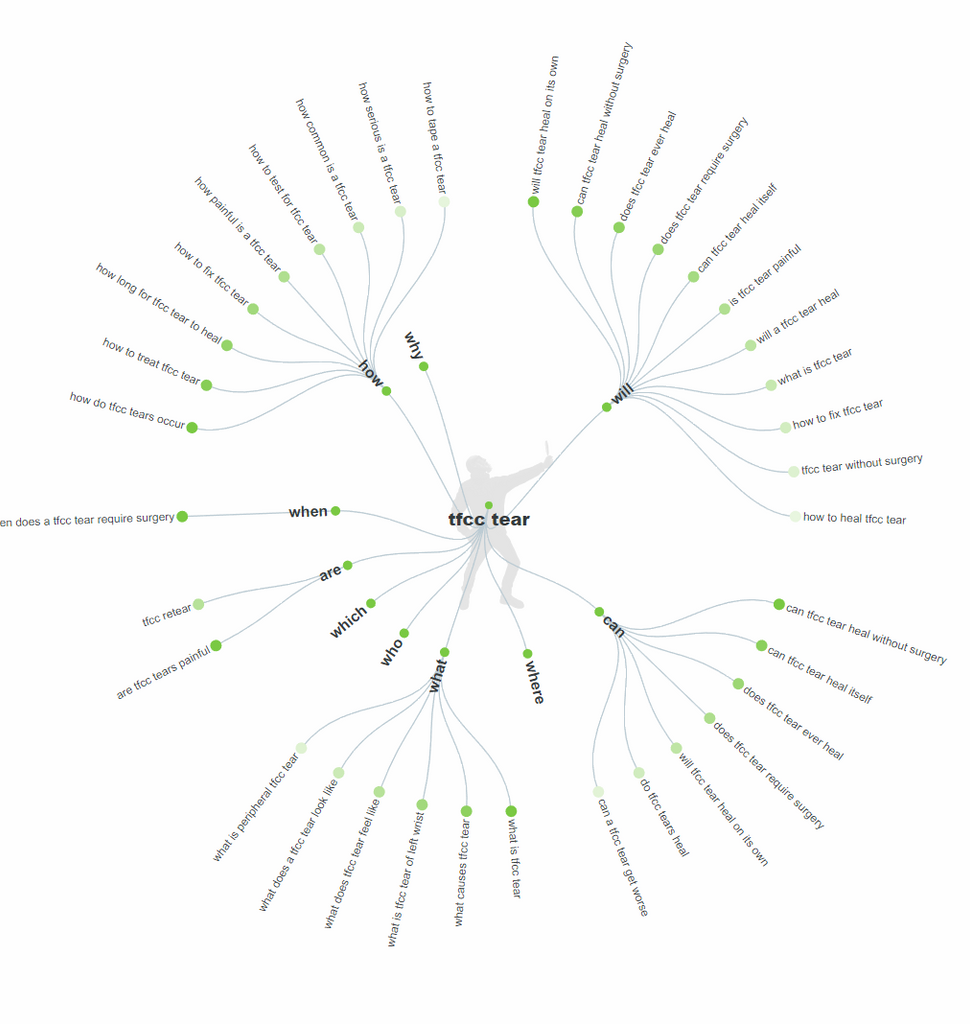TFCC Tear Questions & Answers

So many questions about the TFCC. The graphic above shows searches made online about this debilitating injury and the quest for knowledge, hope, and assurances.
Causes of a TFCC Tear
The most common cause of a TFCC tear is a fall on an outstretched hand (FOOSH), with palms facing down (pronated). The force from the fall exceeds the TFCC's capacity, which leads to a tear. This can also happen during sports which involve rotation of the wrist such as golf, tennis, hockey, and basketball (to name a few!).
What is a TFCC Tear?
A TFCC tear is a tear of the triangular fibrocartilage complex. Think of the TFCC as a trampoline that covers an area between the radius and ulna (two forearm bones) which has a tear in the middle (central) or outlying (peripheral) area. Pulling on the two forearm bones pulls the tear further apart (ouch!).
Is a TFCC Tear Painful?
Yes! TFCC tears are one of the most common causes of ulnar-sided wrist pain. TFCC tears are especially painful in the weight-bearing position during activities such as pushups.
Symptoms of a TFCC Tear
Pain with weight-bearing (pushing yourself up from a chair or the floor) and rotation (opening a jar) are two of the most common symptoms TFCC tear patients experience.
How Common is a TFCC Tear?
TFCC tears are extremely common. Your likelihood of experiencing a TFCC tear increases with age as well as participation in sports that expose the wrist to a lot of force (baseball, tennis, golf, basketball, hockey, etc.).
Can a TFCC Tear Heal on Its Own?
TFCC tears do heal, but you need to create a supportive environment for it to happen!
Healing a TFCC Tear Without Surgery
Yes! TFCC tears can and do heal without surgery. It's well documented in research, and the thousands of happy WristWidget® users worldwide speak as testament to this!
When is Surgery Needed for a TFCC Tear?
TFCC surgical repairs are ONLY recommended to cases who have not responded to conservative treatment for a period of 6 months (this includes using the WristWidget™ protocol and treatments such as physiotherapy) and/or have a weight-bearing tolerance of less than 20lbs.
Steps to Fix a TFCC Tear
Step 1: Know what you're fixing - Perform the weight-bearing test to confirm injury severity (non-digital scale please).
Step 2: Follow the WristWidget™ protocol and monitor weight-bearing tolerance and symptoms (don't rush this).
Step 3: Gradually reintroduce exercise and physical activity to pre-injury levels (WristAbility can help).
Step 4: Give yourself a pat on the back, you've done it!
How to Heal a TFCC Tear
At WristWidget®, we recommend that everyone who suspects that they have a TFCC tear start by performing the weight-bearing test.
- Know what you're fixing - Perform the weight-bearing test to confirm injury severity (non-digital scale please).
- Follow the WristWidget® protocol and monitor weight-bearing tolerance and symptoms (don't rush this).
- Gradually reintroduce exercise and physical activity to pre-injury levels (WristAbility can help).
- Give yourself a pat on the back, you've done it!
Can a TFCC Tear Worsen?
TFCC tears can worsen if not taken care of. It's important to take action (early action is always best) and address the cause to prevent this from happening.
Treatment Duration for a TFCC Tear
TFCC tear treatment, depending on severity and symptoms, can take anywhere from 2-6 months to regain the same level of function you had prior to injury. (Note: this is longer than the healing phase)
Healing Time for a TFCC Tear
TFCC tears generally heal within 3 months of appropriate care.
Severity of a TFCC Tear
Ask any person with a TFCC tear and they will tell you, "it's serious!". TFCC tears can have a significant impact on a person's quality of life due to pain and discomfort. Although TFCC tears are not life-threatening, they are very real and serious for which appropriate care is recommended.
Testing for a TFCC Tear
We recommend using the weight-bearing test, performed with a non-digital scale, to test and track TFCC tear severity and healing progress.
